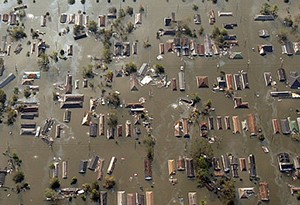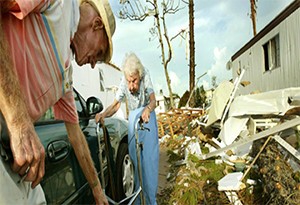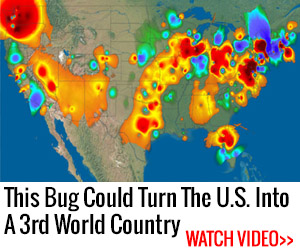by Russ Fuller
The information contained in this series is for informational purposes only. A medical professional should be consulted before taking any actions. It should also be noted that due to the varying levels of knowledge among preppers, this series will explain the most basic actions that can be taken through advanced levels of preparedness.
During Hurricane Katrina, 71% of those that died in New Orleans were over the age of 65, but the elderly population at that time represented 17% of the city. While many examples could be given of people that unnecessarily died in Katrina, perhaps one of the most heart wrenching is the story of Benilda Caixeta. Benilda was a quadriplegic who was confined to a motorized wheelchair. Within minutes of the evacuation order being given, she called for help to evacuate. Benilda contacted 911 as well as many friends and family (who did not live nearby) to ask for help with evacuation. Her friends and family also called, begging to have her rescued, right up until the hurricane made landfall. The first responders she called were overwhelmed and she had no network (friends, family, or caretakers) in place where she lived. Having no network in place left her even more at-risk. At several points, she attempted to take public transportation, but there was no room on the buses that came to her area. Making it worse yet is that there were numerous reports that handicap accessible buses were sent to her area, but able bodied people pack the bus and there was no room for those that had a disability. After Hurricane Katrina passed, Benilda’s body was found, still strapped into her motorized wheelchair. She had drowned.
 Looking at stories like Benilda’s helps us to realize that prepping for disabled/elderly individuals can be a huge task. The Center for Disease Control reports that one in every four people have some type of disability. The census bureau reports that one in every five individuals in the United States is over the age of 65. One problem that is apparent is that disabled/elderly individuals all have different needs; no two people or their needs are exactly alike. This is especially true when they have multiple disabilities.
Looking at stories like Benilda’s helps us to realize that prepping for disabled/elderly individuals can be a huge task. The Center for Disease Control reports that one in every four people have some type of disability. The census bureau reports that one in every five individuals in the United States is over the age of 65. One problem that is apparent is that disabled/elderly individuals all have different needs; no two people or their needs are exactly alike. This is especially true when they have multiple disabilities.
If certain disabilities are not properly managed, this can cause a downward spiral in a person’s health and quality of life. Just as each disability is different, so are the prepping measures. There is no “one-size fits” all way of prepping for disabled/elderly individuals. The uniqueness of each disability and the distinctive needs of each individual often makes prepping for them difficult.
Starting with the basics, the disabled/elderly person should have a typical bugout bag similar to what a typical person would need. In most instances, a second (medical) bugout bag should be created for the older or disabled person. The medical bugout bag should include medical supplies that are specific to them. It should be stocked with supplies that maintain a medically stable quality of life during a CHTF (Crap Hits the Fan) situation. These two bugout bags should be prepping 101 and the starting point for every disabled/elderly individual.
The best way to decide what is needed in a medical bugout bag is to find out what the individual uses to sustain their health and quality of life. Once the medical bugout bag is put together, the disabled/elderly individual and their caretaker should spend at least one day using only the supplies in the medical bag. If they do not use a caretaker, they should perform this with a friend or family member. This is an important job that should be done in a non-disaster setting to make sure that nothing is missing. During the day of testing, if something is needed from outside of the medical bag, then that item should be noted and later included when re-stocking the bag at the end of the day. If something is used that will not fit inside the bag, that item should be written down and attached to the outside of the bag. Some people laminate the list of items that won’t fit in the bag and zip tie the list to a bag handle, while others use standard luggage tags. As long as the list will not be forgotten, and nothing is missing from the list, it does not matter how it is attached.
Related: Going Beyond the Bug-Out-Bag
 After creating a typical bugout bag and a medical bugout bag, the next task is to create a network of individuals who will make sure that the disabled/elderly individual will be safe in a disaster. When creating a network, you can consider friends, family, caregivers, neighbors, and other such individuals who can provide early assistance if not long-term care. It is important to make sure that this network is more than one or two people, and that the individuals you chose for this network are reliable and care enough to jump into action.
After creating a typical bugout bag and a medical bugout bag, the next task is to create a network of individuals who will make sure that the disabled/elderly individual will be safe in a disaster. When creating a network, you can consider friends, family, caregivers, neighbors, and other such individuals who can provide early assistance if not long-term care. It is important to make sure that this network is more than one or two people, and that the individuals you chose for this network are reliable and care enough to jump into action.
Related: What You Need in Your SHTF Survival Team
While creating your network is a good start, there also needs to be good communication between network members. Communication will help to avoid a duplication of efforts or a mix-up in who will take care of which task(s). If the disabled/elderly person needs to bugout, then the network would coordinate with each other to make sure the individual was not forgotten. The network would also communicate with each other to make sure enough resources were on the way to take care of that individual. You should understand that during a CHTF situation, first responders will probably be short-handed and be overwhelmed. It is entirely possible that no matter how much they want to help, there will not be enough of them to respond to everyone and the help you need may never come.
To make sure the network is kept up to date, the disabled/elderly individual and/or their caretaker must keep a written copy of contact information. This will be important in providing open communication and updates when a disaster or a CHTF situation occurs. In some instances, family members may live in another state, which makes it even more important to have a local network that can care for the individual until family members can rescue them. In a situation where communications are down, this may be more challenging, so a basic backup plan should be worked out which could be used when there is no communication in a disaster. As with any disaster plan, the “no communication plan” should be tested.
Related: The Only Form of Communication After T-SHTF
 It is the responsibility of the disabled/elderly person, or their caretaker to provide their network a detailed list of their specific needs, medicine schedules, and where their supplies are kept. This should be done long before an incident ever happens. Any time there are changes, the network should be updated. Besides changes to the list, a new list should be provided to the network every six months. This is important because medical doctors sometimes change medicines and some supplies cannot be placed in a fixed location such as the hallway closet; they are often used daily. These types of items might include a list of medicines, where durable equipment and supplies (oxygen concentrators, breathing machines, IV pumps, ventilators, etc.) are kept, and what assistive devices might be needed to keep them independent. Devices for independence could include scooters, wheelchairs, canes, walkers, service animals, and more. Making sure assistive devices go with the individuals is especially important in a bugout situation to ensure that their quality of life is not compromised.
It is the responsibility of the disabled/elderly person, or their caretaker to provide their network a detailed list of their specific needs, medicine schedules, and where their supplies are kept. This should be done long before an incident ever happens. Any time there are changes, the network should be updated. Besides changes to the list, a new list should be provided to the network every six months. This is important because medical doctors sometimes change medicines and some supplies cannot be placed in a fixed location such as the hallway closet; they are often used daily. These types of items might include a list of medicines, where durable equipment and supplies (oxygen concentrators, breathing machines, IV pumps, ventilators, etc.) are kept, and what assistive devices might be needed to keep them independent. Devices for independence could include scooters, wheelchairs, canes, walkers, service animals, and more. Making sure assistive devices go with the individuals is especially important in a bugout situation to ensure that their quality of life is not compromised.
Related: How to Get a Cheap Survival Shelter and Bug Out Location (Under $5000)
When the individual gets to the bugout location, there will be enough work for the able bodied to do without having to take time to help grandma or grandpa to the bathroom. This is especially true when they could have done their business on their own, had you thought to bring their walker. Smaller assistive devices should also be remembered. Something as simple as a “Bottom-Buddy” (which is an assistive device for wiping a bottom) could cause a caretaker or family member to undertake the unpleasant task of wiping a disabled/elderly adult’s backside. Worse yet, health problems could arise if the individual is too embarrassed to ask for help in that area.
Not only should a network communicate with each other and plan together, but they should also practice the plan at least once per year and if possible, twice per year. If you are planning for a long-term CHTF scenario, work together and either bring the individual to the bugout spot and practice the plan to shelter in place, providing it will not compromise the safety of the elderly or disabled individual. If possible, go off grid for a few days (or up to a week) to ensure everything you planned works in the way you planned it. It is better to have a failure in the planning stage than to have a failure in a real-life scenario. At least then you can make changes to mitigate any problems and come up with another plan. Of course, you should test the alternative plan as well.
Over the next seven weeks, we will be publishing more articles to assist you in prepping for disabled/elderly populations. Some of the topics covered will include how to provide power for durable and mobility equipment, prepping for mobility impairments, prepping for hearing, speech, and sight impairments, prepping for cognitive and psychological disorders, how to prep for institutionalized individuals (nursing homes, adult daycare, etc.), and prepping for service animals. If this series is interesting or important to you, please leave comments letting us know so. Upon completion of the series, we plan to address any specific questions that were not answered during the writing of this series.
What a Prepper Should Do Around The House
H2O Dynamo – The Awesome Device That Turns Air Into Fresh Water! (Video)
50 Days of ‘Survival’ Calories with Rice and Beans
Scare Them Off Or Shoot Them Dead?
EMP Myths and Facts. What’s BS and What’s True?
About the Author: Russ Fuller is not this contributor/authors real name. The author is an avid prepper who is well-known in the public safety field. He uses a pen name to protect his identity due to the stigma that surrounds prepping and survival from those that are not preppers. He feels this stigma could damage his reputation, credibility, and his employment in public safety. In his job, he helps disabled and elderly individuals prepare for short-term disasters and is considered a subject matter expert in the field.
















Thanks for the advise. I have some limited mobility issues and think I have a good idea how to handle things but it is always good to get more ideas and discover better ways to be prepared. Look forward to learning more. Thanks again.
Mr. BILL,
I am disabled, dependent upon my meds to stay alive. I have tried to get my Dr. to “Prescribe for war”, but he refuses. So when my 90 day supply runs out, I have maybe two weeks to live. I will be one of the first to die. Not a very good prospect to look forward to. My live in is even worse with COPD, once the mains go down, so will she. The able bodied will say that it is our fault we got this way, but diabetes is genetic, as is anxiety conditions. The able bodied will wait for us to die so they can raid our home for the dregs we didn’t use, stepping over our corpses to get what is left. That is, if we survive that long. So many other Americans are in the same boat as me, or worse. Real estate owned by the disabled will be really cheap for the taking. I just hope they will be Christian enough to bury us neatly before they steal our stuff, that might be payment enough for the stuff we abandon in death. I have prepared for 120 days, that is all I will need. But if they want it before we are dead, they will have to fight for it – and I have some really nasty surprises waiting for them, from gas to punji traps. And I WILL use them, I have the will and the desire to do so. Defense in depth I think it is called, and radio comms to call in the cavalry if needed. Call me “somewhere in Georgia” for security.
I am in a wheelchair an trying to prep thanks for discussing this subject. I have been a prepper for a long time an now I have abounch of new problems thanks for the info I need.
Working as an emergency manager, your thoughts and insights are extremely valuable in preparing for disasters for our functional needs population. Looking forward to this series!
Thanks Guarddog! I also work in the field, and and have a passion for AFN Preparedness. This is an extremely important mission for me!
How do you get your medicines in advance I can’t get pharmacy to sell them to me? I am only on insulin, BP and cholesterol meds.
Hey Shirley- I’ve been using a mail order Rx service for about 5 years. My health plan discounts my prescriptions 66%, but the big benefit is they are always timely with delivery. So much so, that I almost have a year supply in surplus. Not only do I have my meds, but even if they change, I have “trade bait” to get what I don’t have or help someone who is in a bind.
Hi Shirley,
There are several ways to handle stockpiling your needed medicines. Rick brought up one good way to begin to stockpile. Another way is to find out from your pharmacist the earliest date that you can refill. Most pharmacies and insurance companies will allow purchasing 2-3 days prior to the medicines running out. If it is allowed and you do this monthly, you can gain 2-3 days per month. In some cases you can talk with your medical doctor, and once per year they will allow you to obtain an extra months supply of medicines, but in most instances you will have to pay cash and use a different pharmacy. Finally, you can speak with a holistic doctor and find natural medicines that may work for your specific medical needs. In all honesty, stockpiling medicines is perhaps the hardest part of prepping. One thing to remember is medicines have expiration dates, so you will need to use the oldest expiration dates medicines first. Also, different states have different laws, so you may need to find someone that knows the law in your state to make sure you are not breaking state law. I hope this helps.
Thanks wife has M.S. we have been looking for some guidance on what we can do in a SHTF scenario.
I greatly appreciate the insures offered here.
Regarding meds, there are also many meds alternatives that can be had intablet/pill form, instead of capsule.
My Doc prescribes double dose strengths, which can be cut in half, giving me twice the # of doses, for nearly the same price. Ie: I take 500 mg per day, yett Rx is for 1000 mg tabs. So, I get 60 doses for every 30 pills ordered.
Just another way to help stockpile.
Hi Meade,
While this is not impossible, in most instances it is illegal. Anything not available over the counter is regulated by law, and both the doctor and the patient could get into legal trouble. Also, if it is paid for by the insurance company, it could be considered insurance fraud. If your state does allow it, then this is a VERY good way to stockpile medicines.
Thank you